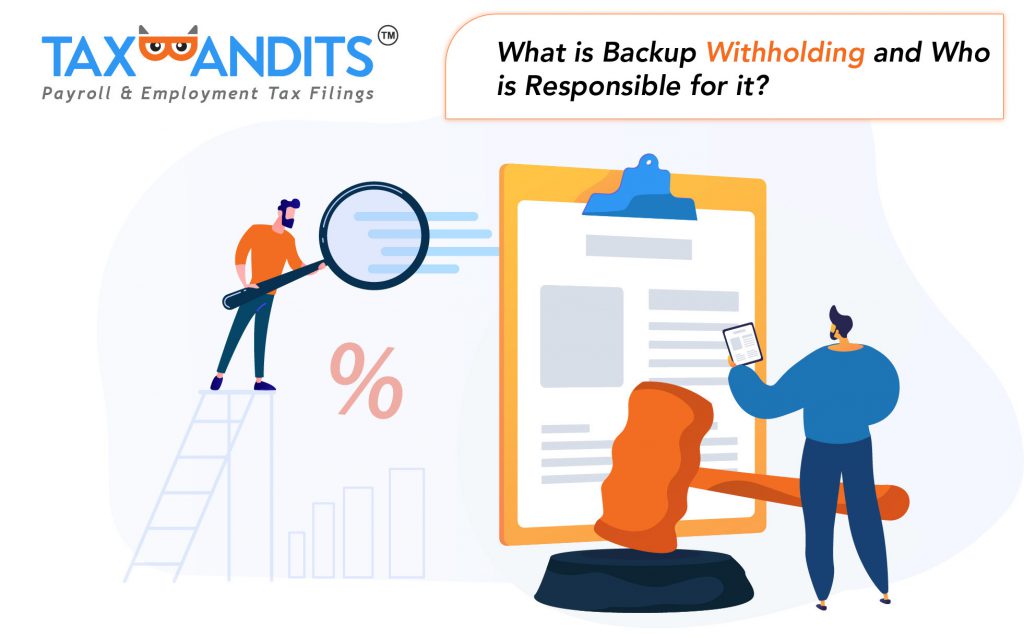What is Backup Withholding and Who is Responsible for it?

Here at TaxBandits, our team gets a lot of questions about backup withholding. Many employers and business owners are unsure about how it works and when they are required to put it into effect. With the year-end deadlines looming ahead of us, now is a great time to address all of the most frequently asked questions about backup withholding.
How does the IRS define Backup Withholding?
According to the IRS, backup withholding requires a payer to withhold taxes from payments that are otherwise not subject to any withholding. You fall subject to backup withholding if you fail to provide a correct taxpayer identification number (TIN) when required or if you fail to report interest, dividend, or patronage dividend income.
So, what does this actually mean? This means that if you are doing business with an entity that requested a Form W-9 from you, and you fail to provide the information required on this form, you will become subject to backup withholding. Form W-9 is a Request for the Taxpayer Identification Number and Certification.
As a payer, if you request Form W-9 from a payee and they fail to respond with an accurate TIN, you are required by the IRS to begin backup withholding. Again, according to the IRS, if the TIN is missing or cannot be verified” this is cause for backup withholding.
Will the IRS Notify my Business if Backup Withholding is Required?
While you should always make an effort to get the payee’s TIN before this point, the IRS does send out notices to businesses when backup withholding is required. The Notice CP2100 also called a “B-Notice” lets your business know that the payee has a missing or invalid TIN. You must respond to the notice and send another Form W-9 to the payee.
Regardless of which IRS Notice you receive, you must begin backup withholding no later than 30 days after the notice arrives.
How Much Should be Withheld?
Unless the payee responds with an accurate TIN within 30 days, you must begin withholding 24% of all their payments. This amount should continue to be withheld no longer than 30 days after the payee provides their TIN.
Why is the Taxpayer Identification Number so Important?
You may be thinking, this is a lot of fuss for a string of numbers, and you’re not wrong, however, the TIN is crucial to all businesses, organizations, and individuals that are required to report payments to the IRS.
The Form 1099 Series is used to report a variety of payments to the IRS, without filing these forms accurately, business entities jeopardize their IRS compliance and face penalties.
What kinds of Payments are Subject to Backup Withholding?
The following types of payments are subject to backup withholding:
- Payments to independent contractors reported on Form 1099-NEC
- Interest payments reported on Form 1099-INT
- Government payments reported on Form 1099-G
- Dividends reported on Form 1099-DIV
- Miscellaneous payments (rents, royalties, profits, etc) reported on Form 1099-MISC
- Broker and Barter payments reported on Form 1099-B
- Patronage dividends reported on Form 1099-PATR
- Third-party Network Transactions reported on Form 1099-K
How to Prevent Backup Withholding?
You may have noticed that the Form W-9 has appeared many times throughout this article, that definitely isn’t a coincidence. This form is the answer to preventing backup withholding. Requesting that every vendor you do business with completes and signs this form is the easiest way to ensure you have valid information from your payees.
Did you know that TaxBandits allows you to request your Form W-9s electronically? This is so much easier than asking your vendors to complete a paper copy and potentially mail or fax it to you. Not only will you save time, but you can store this information for future reference and to complete your year-end Form 1099 filing.
Start requesting your Form W-9s hassle-free with TaxBandits today!



